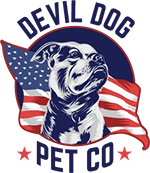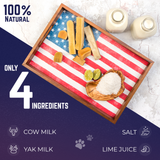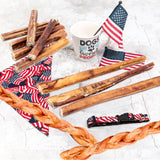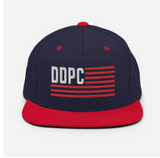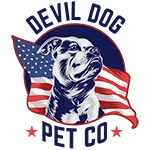Key Takeaways
- Beef tendon is a natural, dense connective tissue from cattle that links muscle to bone and offers functional nutrition.
- It provides natural collagen, dental benefits, and long-lasting chew satisfaction for dogs when sourced ethically and sized properly.
- Beef tendon chews retain their original protein structure due to minimal processing, making them durable and easily digestible.
- Single-ingredient, grass-fed beef tendons are superior to synthetic chew alternatives.
- Proper supervision and gradual introduction are essential for safe and effective use of beef tendon chews for dogs.
Table of Contents
- What Is Beef Tendon for Dogs?
- The Health Benefits of Beef Tendon Chews
- Comparing Beef Tendon Chews to Other Popular Dog Chews
- Choosing the Right Beef Tendon Chew for Your Dog
- Safe Handling, Feeding & Supervision: Real-World Best Practices
- How to Prepare Homemade Beef Tendon Treats for Dogs
- Troubleshooting Common Beef Tendon Chew Problems
- Where to Buy the Best Beef Tendon Chews for Dogs
Beef Tendon for Dogs – Vet-Backed Safety & Benefits
What Is Beef Tendon for Dogs?
Definition & Anatomy
Beef tendon is the dense connective tissue that links muscle to bone in cattle, naturally tough, fibrous, and packed with functional nutrition. Unlike processed rawhide or synthetic chews, beef tendon for dogs maintains its original protein structure through minimal processing, creating a chew that's both durable and completely digestible.
If you're looking for other natural, long-lasting options, long lasting dog chews can also provide extended engagement and dental support for your pup.
This connective tissue contains approximately 70-90% protein by dry weight, with 25-30% of that being pure collagen types I and III. The natural density requires sustained gnawing, making it ideal for mental stimulation and jaw exercise that modern kibble diets often lack.
For dogs that enjoy a variety of chews, consider rotating tendon with bully sticks to keep your pet interested and satisfied.
Nutritional Profile
A typical 6-inch beef tendon for dogs delivers 60-90 calories of nearly pure protein with negligible fat content. The collagen concentration provides glycine, proline, and hydroxyproline, amino acids that support joint cartilage, skin elasticity, and coat shine.
Unlike bully sticks or rawhide, tendon chews contain no artificial preservatives, colorants, or flavor enhancers. The natural drying process concentrates nutrients while eliminating moisture that could harbor bacteria.
Sourcing & Processing
Premium beef tendons for dogs come from grass-fed cattle in the United States and South America. The processing involves washing, trimming excess fat, slicing into uniform rods, then slow-drying at 140-180°F for 20-48 hours until moisture content drops below 10%.
This dehydration method preserves nutritional integrity without chemical softeners or bleaching agents. The result: a shelf-stable chew that maintains its natural amber color and mineral-rich composition for 12-18 months when stored properly.
The Health Benefits of Beef Tendon Chews

Dental Hygiene & Plaque Removal
The fibrous texture of tendon chews for dogs acts like natural dental floss, scraping plaque buildup while massaging gum tissue. Studies indicate that regular chewing can reduce soft plaque by up to 20% when combined with proper dental care routines.
For more expert advice on maintaining your pet's dental health, see these tips for taking care of your dog's teeth.
Unlike harder chews that risk tooth fractures, tendon provides moderate resistance that cleans without excessive force. Two to three 15-20 minute sessions weekly optimize dental benefits without overworking jaw muscles.
Joint, Skin & Coat Support
The collagen peptides in dog tendon treats break down during digestion into amino acids that support cartilage synthesis and skin barrier function. Dogs typically show improved coat shine and joint mobility after 4-6 weeks of regular tendon consumption.
Senior dogs with mild stiffness often benefit most, as the bioavailable collagen supplements their body's declining natural production. However, tendon chews complement, not replace, veterinary-recommended joint supplements for arthritic conditions.
Mental Stimulation & Anxiety Relief
Extended chewing triggers endorphin release, creating a natural calming effect that helps anxious dogs self-soothe. Dog chew tendons provide 20-60 minutes of focused activity, making them excellent for crate training, separation anxiety, and redirecting destructive behaviors.
The sustained effort required to break down tendon fibers satisfies the instinctual need to work for food, reducing boredom-driven mischief in high-energy breeds.
Comparing Beef Tendon Chews to Other Popular Dog Chews
Selection Criteria
We evaluated dog tendon chews against alternatives based on safety profile, nutritional value, digestibility, dental benefits, durability, and cost-effectiveness. Each comparison focuses on practical outcomes for responsible dog owners committed to quality over convenience.
| Criteria | Beef Tendons | Bully Sticks | Rawhide | Antler Chews |
|---|---|---|---|---|
| Hardness Level | Medium-Hard (7/10) | Medium (6/10) | Variable (4-8/10) | Very Hard (9/10) |
| Collagen Content | 25-30% | Trace amounts | High but poorly digestible | Minimal |
| Digestibility | 95-97% | 98-99% | 30-60% | Not edible |
Beef Tendons vs. Bully Sticks
Best for: Owners seeking collagen benefits with moderate chew resistance
| Criteria | Beef Tendons | Bully Sticks |
|---|---|---|
| Hardness Level | Very tough (8/10) | Moderate (6/10) |
| Collagen Content | 25-30% | Trace amounts |
| Protein Concentration | 70-90% | 80-90% |
| Odor Profile | Minimal to none | Mild to strong "barnyard" smell |
| Digestibility | 95-97% | 98-99% |
| Average Chew Time | 20-60 minutes | 15-45 minutes |
| Stomach Sensitivity | Rare upset | Occasional with excess consumption |
Tendon dog chews excel in joint support applications, while bully sticks offer faster consumption with higher palatability. Power chewers benefit more from tendon's extended engagement time.
If your dog prefers a more substantial chew, the 12" Ultra Thick Bully Stick - 3pk is a great alternative for heavy chewers.
Beef Tendons vs. Rawhide
Best for: Safety-conscious owners avoiding digestive blockage risks
Rawhide undergoes chemical bleaching and processing that strips natural nutrition, while beef tendon dog chews maintain their original protein matrix. Tendon's 95-97% digestibility eliminates the blockage concerns associated with rawhide's poor breakdown in stomach acid.
The single-ingredient nature of quality tendon chews means no artificial preservatives or chemical residues, a stark contrast to rawhide's typical processing additives and potential contamination risks.
For a deeper dive into the safety of popular chews, read bully sticks for dogs: are they safe?.
Beef Tendons vs. Antler Chews
Best for: Dogs needing nutritional value alongside dental benefits
Elk antlers provide maximum durability but zero digestible nutrition, while beef tendon dog chews offer complete consumption with collagen benefits. Antlers suit power chewers who can handle extreme hardness, but risk dental fractures in aggressive biters.
Tendon strikes the middle ground, tough enough for extended chewing yet soft enough to avoid tooth damage, making it suitable for a broader range of dogs including seniors and moderate chewers.
For those considering antler options, explore the antler dog chews collection for a variety of sizes and types.
Choosing the Right Beef Tendon Chew for Your Dog
Size, Shape, and Texture Matching
Small breeds and puppies require thin, 3-4 inch tendon pieces that won't overwhelm developing jaws. Large breeds and power chewers need thick, 6-8 inch rods with maximum density to provide appropriate challenge and prevent rapid consumption.
Picky eaters often respond better to lightly roasted tendon treats for dogs that offer enhanced aroma without artificial flavoring. The natural smoking process intensifies beef scent while maintaining nutritional integrity.
For large breeds, check out the 45-70 lbs selection for appropriately sized chews.
Life Stage & Health Considerations
Puppies over 4 months can safely enjoy tendon chews with gradual introduction, start with 5-minute supervised sessions to monitor tooth and gum response. Senior dogs benefit from softer, collagen-rich options that support joint health without straining fragile molars.
Dogs with beef sensitivities rarely react to pure tendon since most allergies target muscle proteins rather than connective tissue. However, always consult your veterinarian before introducing new proteins to sensitive dogs.
Ethical Sourcing Standards
Premium dog tendons come from grass-fed, free-range cattle with transparent supply chains. The ingredient label should read "beef tendon" only, no fillers, preservatives, or processing aids.
Avoid products from unknown origins or those lacking clear sourcing information. Quality suppliers provide batch tracking and third-party testing verification for food safety compliance.
Safe Handling, Feeding & Supervision: Real-World Best Practices

Safe Chewing Protocols
Limit initial sessions to 15-20 minutes for tendon newcomers, extending up to one hour for experienced chewers. Never leave dogs unattended with dogs tendons, retire the chew when it becomes small enough to swallow whole.
Offer chews on rugs or mats to protect hardwood floors from potential scratches. The dense nature of dried tendon can mark soft surfaces if dropped repeatedly during vigorous chewing sessions.
Introduction Best Practices
Present tendon chews after meals rather than on empty stomachs to reduce digestive sensitivity. Monitor dogs for 48 hours for digestive changes. Rotate tendon chews with other options like yak chews or bully sticks to maintain interest and prevent overconsumption.
If your dog enjoys cheese-based chews, the Large - Himalayan Dog Chew - 1 Pack is a highly digestible alternative to tendon and rawhide.
Storage and Shelf-Life
Store unused beef tendon chews in airtight containers in cool, dry locations away from direct sunlight. Properly stored tendons maintain quality for 12-18 months. Discard any chews showing signs of mold, sour odors, or slimy texture, these indicate spoilage that could harm your dog.
Avoiding Hazards
Select tendon pieces longer than your dog's muzzle width to prevent swallowing whole pieces. For dogs with histories of dental fractures, choose thinner, more pliable cuts or limit chewing sessions to 10-15 minutes. If your dog attempts to gulp large fragments, immediately remove the chew and inspect their mouth for lodged pieces.
How to Prepare Homemade Beef Tendon Treats for Dogs
Sourcing and Prep
Purchase grass-fed beef tendons from reputable butchers or specialty pet suppliers. Trim away excess fat and connective tissue, then slice into appropriate widths, thumb-thickness for small breeds, index finger-width for large breeds. Rinse thoroughly under cold water and pat completely dry before processing.
Dehydration Process
Set oven temperature to 175°F and arrange tendon pieces on wire racks over baking sheets. Dehydrate for 6-8 hours until pieces achieve a golden-brown color and snap cleanly under firm pressure. Turn pieces halfway through drying to ensure even moisture removal. Properly dehydrated tendons should contain less than 10% moisture.
Safety Protocols
Never add salt, spices, marinades, or flavor enhancers during preparation, these can cause digestive upset or toxicity. Test doneness by attempting to snap a cooled piece; it should break cleanly rather than bend. Allow complete cooling before storage in airtight containers.
Troubleshooting Common Beef Tendon Chew Problems
Choking Prevention and Response
Remove chews immediately if dogs attempt to swallow large pieces whole. Check airways for obstructions and contact veterinarians for persistent gagging, excessive drooling, or breathing difficulties. Size chews appropriately from the start, pieces should extend beyond the dog's back molars when held sideways in their mouth.
Emergency Response: If choking occurs, open the dog's mouth, look for visible obstructions, and attempt gentle removal with tweezers. Never push objects deeper. Seek immediate veterinary attention for any breathing distress.
Digestive Management
Loose stools, vomiting, or appetite loss signal overconsumption or sensitivity. Withdraw tendon chews for 72 hours, then reintroduce smaller portions after complete recovery. Some dogs require gradual conditioning, start with 5-minute sessions and extend duration as tolerance builds.
Quality Control
Inspect chews before each session for fuzzy mold growth, off odors, or slimy surfaces. Properly stored beef tendon for dogs maintains a firm, dry texture with minimal scent. Always air-dry chews after slobber-heavy sessions to prevent bacterial growth during storage.
For more information on the nutritional composition and structure of beef tendon, see this Wikipedia article on beef tendon.
Where to Buy the Best Beef Tendon Chews for Dogs

Selection Standards
Prioritize suppliers offering single-ingredient beef tendon from grass-fed, free-range cattle. Verify transparent sourcing practices and avoid products containing bleach, artificial flavors, or chemical preservatives. Quality suppliers provide detailed processing information and maintain consistent sizing standards.
| Brand | Source | Processing | Size Options | Key Features |
|---|---|---|---|---|
| Devil Dog Pet Co | USA/South America Grass-Fed | Oven-Baked | 4-8 inch rods | Veteran-inspected, ethically sourced, hand-selected |
| Generic Brand A | Various | Air-dried | Limited sizes | Basic quality control |
| Generic Brand B | Unspecified | Dehydrated | Standard sizes | Mass-produced |
Purchasing Strategy
Buy in bulk quantities (6-12 piece packs) for better value and consistent supply. Subscribe to reputable suppliers for seasonal discounts and automatic delivery schedules. Calculate cost-per-hour of enrichment rather than focusing solely on upfront price, quality beef tendon for dogs provides extended chewing sessions.
For those interested in the nutritional benefits of other beef-based treats, explore beef heart for dogs as a protein-rich option.
Red Flags to Avoid
Reject products listing artificial flavoring, chemical softeners, or unspecified "natural flavors." Avoid suppliers unable to provide sourcing information or third-party safety verification. For a scientific perspective on the digestibility and safety of animal-based chews, refer to this peer-reviewed study on pet chew digestibility.
Frequently Asked Questions
What are the main health benefits of giving beef tendon chews to dogs?
Beef tendon chews provide natural collagen that supports joint health, promote dental hygiene by reducing plaque buildup, and offer long-lasting mental stimulation through sustained chewing. They are high in protein and low in fat, making them a nutritious, functional treat for dogs.
How does beef tendon compare to other popular dog chews like bully sticks or rawhide?
Beef tendon chews retain their original protein structure with minimal processing, making them more durable and easily digestible than rawhide. Compared to bully sticks, tendons offer a denser, longer-lasting chew with natural collagen benefits and fewer additives.
What should I consider when choosing the right beef tendon chew for my dog?
Select a beef tendon chew sized appropriately for your dog's mouth to prevent choking and ensure safe chewing. Opt for single-ingredient, grass-fed tendons sourced ethically to guarantee quality and durability. Consider your dog's chewing style and dental health when making your choice.
What safety precautions and supervision are recommended when feeding beef tendon chews to dogs?
Introduce beef tendon chews gradually and always supervise your dog during chewing to prevent swallowing large pieces or choking. Monitor chewing behavior and remove the chew when it becomes small enough to swallow whole. Ensure fresh water is available and consult your vet if you have concerns about your dog's chewing habits.
